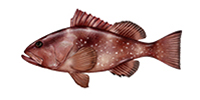Thank you for visiting the Seafood Selector. EDF is planning a new approach to providing information to consumers about good seafood choices. Please come back soon for updates.
Grouper

Red grouper
Recommended servings per month
| Contaminant | Men | Women | Kids 6-12 | Kids 0-5 | |
|---|---|---|---|---|---|
| Grouper (imported) | Mercury | 2 | 2 | 1 | 1 |
| Black grouper (U.S. Gulf of Mexico) | Mercury | 2 | 2 | 1 | 1 |
| Red grouper (U.S. Gulf of Mexico) | Mercury | 2 | 2 | 1 | 1 |
| Snowy grouper (US) | |||||
| Gag grouper (US, Gulf of Mexico) | |||||
| Warsaw grouper (US) | |||||
| Yellowedge grouper (US) |
Eco details:
- Grouper fisheries are depleted in many parts of the world. One reason is their unusual mating ritual: mature fish come together to spawn in huge numbers that make them easy targets for fishermen. This removes many reproducing fish and challenges the recovery of their populations.
- Two exceptions are red and black grouper from the U.S. Gulf of Mexico, which are no longer overfished.
- A new catch share management plan ensures that fishermen stay within their catch limits and minimize bycatch of other depleted grouper species.




